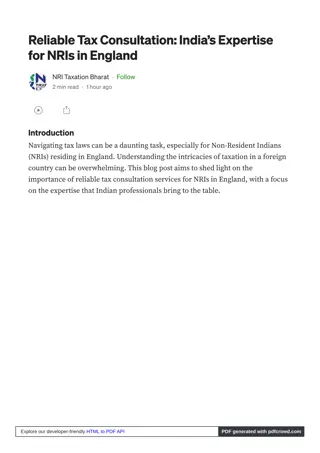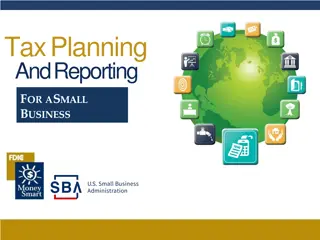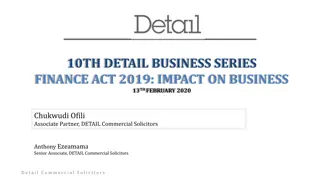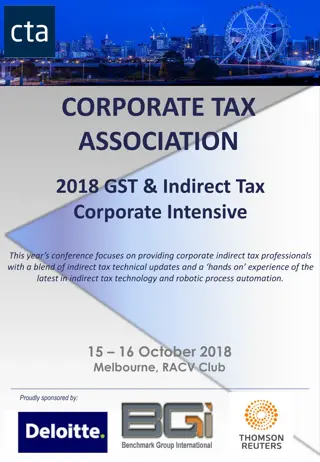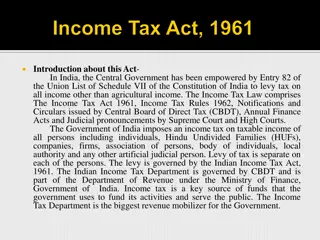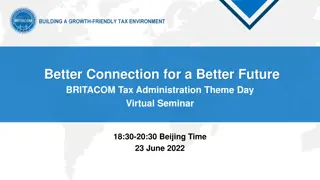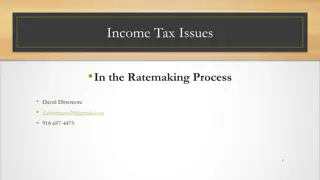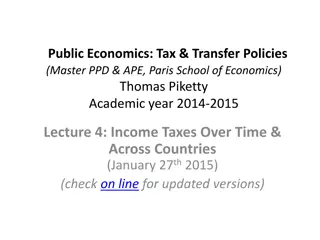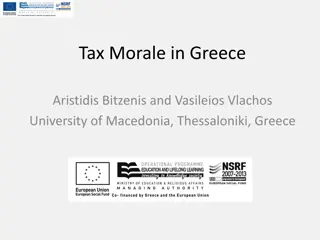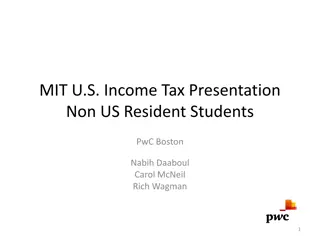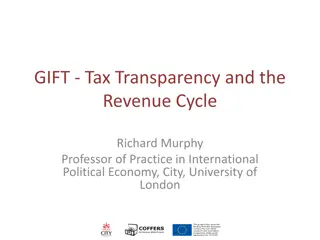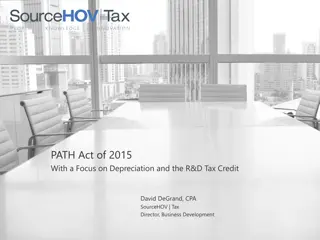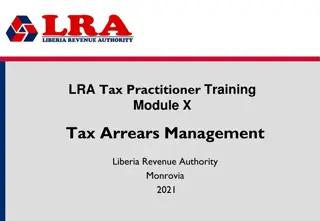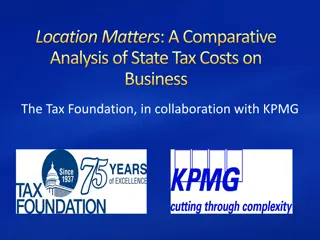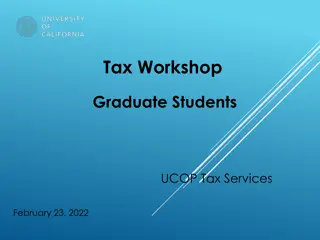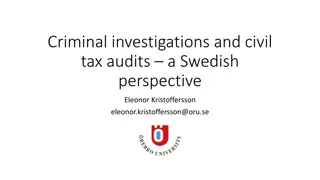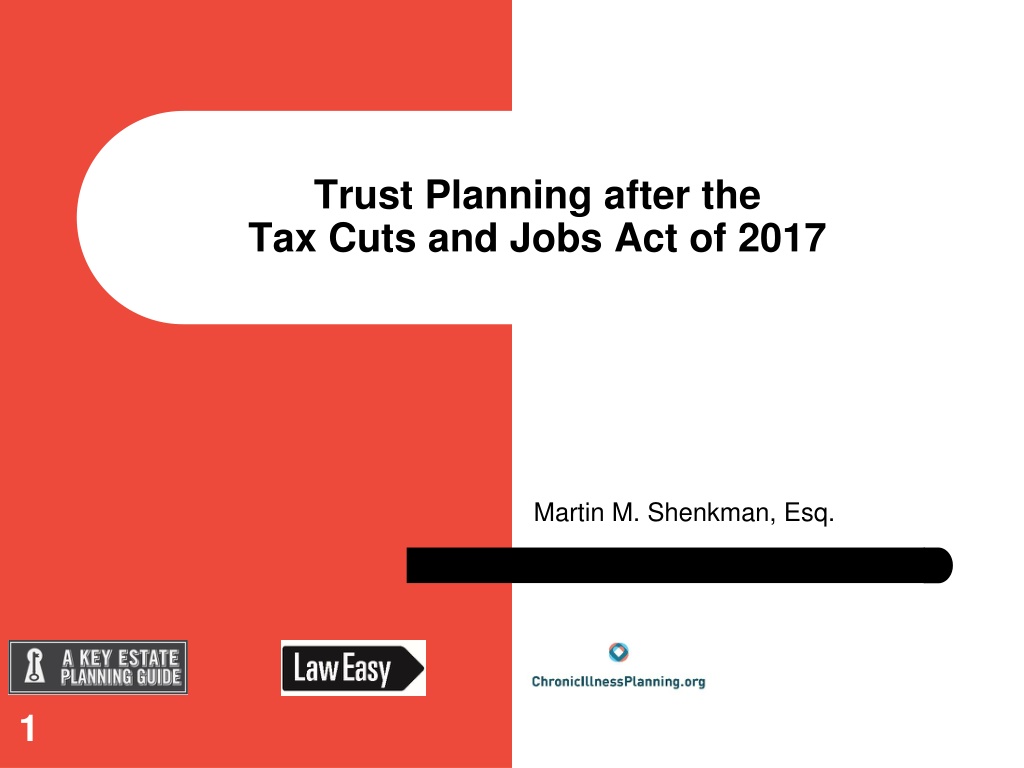
Trust Planning Strategies Post Tax Cuts and Jobs Act 2017
Discover advanced wealth planning ideas post the Tax Cuts and Jobs Act of 2017, including UHNW planning considerations, trust structuring, and tax strategies for high-net-worth clients.
Download Presentation

Please find below an Image/Link to download the presentation.
The content on the website is provided AS IS for your information and personal use only. It may not be sold, licensed, or shared on other websites without obtaining consent from the author. Download presentation by click this link. If you encounter any issues during the download, it is possible that the publisher has removed the file from their server.
E N D
Presentation Transcript
Trust Planning after the Tax Cuts and Jobs Act of 2017 Martin M. Shenkman, Esq. 1
General Disclaimer The information and/or the materials provided as part of this program are intended and provided solely for informational and educational purposes. None of the information and/or materials provided as part of this power point or ancillary materials are intended to be, nor should they be construed to be, the basis of any investment, legal, tax or other professional advice. Under no circumstances should the audio, power point or other materials be considered to be, or used as, independent legal, tax, investment or other professional advice. The discussions are general in nature and not person specific. Laws vary by state and are subject to constant change. Economic developments could dramatically alter the illustrations or recommendations offered in the program or materials. 2
Planning after the Tax Cuts and Jobs Act of 2017 Introduction 3
Topics UHNW Planning. Planning ideas, issues, considerations. Defined value mechanisms. Structuring trusts. Action Steps to Move Forward. Advanced Income Tax Ideas and Fiduciary Income Tax Strategies Homes held by Non-Grantor Trusts. Business interests fractionalized and held by Non-Grantor Trusts. Saving state income taxes with non-grantor trusts. NIIT tax planning. Action Steps to Move Forward Decanting, Reformations, and more. How to modify/cancel old trusts. Issues that may arise Action Steps to Move Forward 4
Planning after the Tax Cuts and Jobs Act of 2017 Planning by Wealth Level 5
UHNW Clients: Planning with the New Exemptions For large estates, the increased exemption should be used, likely in leveraged transactions to maximize the wealth transfers from the increased exemption. For example, if as some commentators suggest a 10:1 ratio (others suggest a 9:1 and many disagree with this concept entirety) leverage is appropriate on a sale of assets to a trust an additional $10 million of exemption for a married couple might support a $100 million sale of assets to irrevocable trusts. Further, since the IRC Sec. 2704 Regulations have been withdrawn, that sale may be of discounted assets leveraging the wealth transfer upwards of perhaps $130 million of assets on the new exemption amount. 6
UHNW Clients: GST: Planning For larger estates, more sophisticated planning may be advisable to shift value from non-GST exempt trusts to GST exempt trusts. Example: If exemption has been used and GRATs are employed have the back end be an existing non-GST exempt trust that will have a vested remainder which it can then sell to an older existing GST exempt trust. Example: A family member may create a new irrevocable trust that is a 678 grantor trust as to the existing non-GST exempt trust, funding that new trust using a portion of her new gift and GST exemption. That new trust might then engage in a transaction with the old non-GST exempt trust to shift value into a more optimal transfer tax structure. 7
UHNW Clients: Special Considerations Some of the planning ideas, such as the use of non-grantor to salvage portions of an otherwise lost home property tax deduction may not be worth the bother for larger clients. For example, if a UHNW client s home property tax bill is $100,000, or a multiple of that, how many trusts is it worth creating to salvage a portion of that tax benefit? Non-grantor trust planning for the UHNW client may also be easier than for the moderate wealth client in that the UHNW client, in contrast to a moderate wealth client, may not need access to the assets transferred to the non-grantor trusts. That can avoid several complex tax issues on structuring a non- grantor trust to permit access, as discussed below. 8
Moderate Wealth Clients Moderate wealth may be a wide range from perhaps $5M to as much as $40M relative to the new high exemption amounts. High temporary exemptions $22M/couple, mean plan now. Reduced by in 2026 but could be adversely affected by a new administration before then. Income tax considerations and SALT deductions change the face and goals of planning. Access to assets transferred is more critical than ever with the large dollars that have to be transferred to use exemption currently. This is critical to avoid the so-called buyer s remorse that affected many 2012 last minute estate planning transactions. In many of those plans the transferor/donor made large wealth transfers in the rush of the December 31, 2012 anticipated deadline, and thereafter could not access those funds. In 2018 transfers might need to exceed the $5.6M that the exemption may decline to in 2026 before any exemption benefit is preserved. Second, in 2012 the most irrevocable trusts created to hold gifts and other transfers were structured as grantor trusts. This permitted the spouse to have access and the settlor to borrow trust funds without adequate security. In the current 2018 planning environment it will be advantageous to structure many of the trusts to receive gifts as non-grantor trusts. This will require more complex planning to achieve goals that will appear contradictory. This is explained at greater length below. Consider having one spouse not both use exemption thereby preserving more exemption. 9
Moderate Wealth Clients: Simplify/Enhance Existing Transactions For more moderate wealth clients who have previously consummated note sale transactions, consideration should be given to immediately funding additional gifts to the purchasing trusts to shore up the economics of those sale transactions. On those transactions, consideration might be given to evaluating the need for the existing guarantees. On much larger transactions, the additional trust capital might be supportive, but have no meaningful impact on guarantees. On smaller note sale transactions, that additional $5 million gift might be used to pay off a portion or all of a note, thereby eliminating the IRS IRC Sec. 2036 string argument as to the note. 10
Moderate Wealth Clients: GST - Late Allocations For taxpayers with estates of a size that there is no need to preserve the new GST exemption, it might be prudent to make late allocations of GST exemptions to existing trusts so that if a future administration rolls back the Act s benefits, those trusts will already be exempt (barring some type of claw back). Example: Late allocations of GST to ILITs that were not initially intended to be GST exempt. Should trust be decanted (see below) to enhance protection/benefits? Example: Gift tax returns were not filed, or not filed properly for past gifts. Even though the current large exemption provides no cover for prior gifts it may be advisable to address the clean up in the current environment, e.g. filing returns that were not filed and confirming the belief that GST was automatically allocated to prior transfers. 11
Planning: Using Low Wealth Family Member Exemptions - 1 Capture unneeded transfer tax exemptions of family members or others with modest wealth. The taxpayer could make a gift of highly appreciated assets to a close family member living in a non-decoupled state who has a modest estate of her own, who could bequeath those assets to the descendants of the taxpayer in a GST exempt long term trust. An obvious drawback of this is loss of control over the assets. Create an irrevocable trust with a general power of appointment (GPOA) to a person living in a non-decoupled state who has a modest estate of her own. The presence of that GPOA will cause estate inclusion of trust assets in that person s estate generating no estate tax but an adjustment of basis on her death. The exercise of the GPOA could be conditioned upon the consent of a non-adverse party providing a measure of protection. Alternatively, a limited power of appointment ( LPOA ) could be provided to that person and another person can be given the power to convert the LPOA into a GPOA before the power holder s death. If the trust is formed in a jurisdiction that permits silent trusts, is there a need to even inform the power holder of the existence of the GPOA? Caution: If poor relative/parent gets a GPOA that might expose assets subject to the GPOA to the reach of Medicare. 12
Planning: Using Low Wealth Family Member Exemptions - 2 An upstream GRAT could also be used. Acknowledgement to Turney Berry. Example: Clients have a net worth substantially in excess of the $22 million. The client s parents have a net worth combined of only $2 million. So, the clients create a GRAT that is calculated to vest in each parent somewhat less than the maximum amount which, when added to their other assets, would not exceed each parent s exemption at the time that each parent dies. The parents bequeath the remainder interest to a trust for the benefit of the client and the client s descendants. This transfer will not only use up the parent s estate tax exemption, but it can utilize each parent s GST exemption (because there is no ETIP with respect to the parent). The IRS should have no objection to this planning because it actually uses exemption, rather than being an assignment on day one (or two) of a nominally valued remainder interest. 13
Lower Wealth Clients: Planning For lower wealth clients, existing documents and planning will have to be reviewed. Many clients in this wealth strata will be inclined to unravel prior planning under the premise of Why do I need this now? Practitioners will have to educate these clients as to the value of retaining (whether modified or otherwise) existing planning from a number of perspectives. Many estate planning steps provide asset protection benefits and the transfer tax changes do not minimize the need for that. For some clients if the planning is already in place the modest cost of continuing to maintain that planning may be insignificant relative to the cost of unraveling the planning, and then having to reconstruct it in the future if the law changes yet again (e.g. a reduction in the exemption amount by a future administration). 14
Lower Wealth Clients: Planning Creative applications of non-grantor trusts to garner income tax deductions. Lower wealth clients are often inclined to merely terminate prior planning as irrelevant to them. Practitioners should advise these clients as to the benefits of retaining prior planning, e.g. a life insurance trust to protect the proceeds for intended heirs, as well as the costs and potential problems of simply terminating existing planning. 15
Post-TCJA Trust Planning The bottom line for practitioners is that planning is more complex than ever. Practitioners need a wider variety of trust planning techniques in their tool kits than ever before = More trust and planning acronyms. All this occurs at a time when most even wealthy clients tune out planning recommendations because they view the transfer tax system as irrelevant given the current high exemptions. That will likely prove a mistake for clients who do nothing and miss out on income tax, asset protection, and estate planning that may well prove with hindsight to have been advisable. 16
DAPTs and TCJA DAPTs more Important For Temp. Exemption? 17
Asset Protection and Using the New Temporary Exemption Large use it or lose it exemptions will encourage gifting larger portions of wealth to secure temporary exemptions. Loosen old rules of thumb on percentage of wealth that can be transferred? Solvency affidavits and other due diligence - use more with greater portions of wealth transferred? Access to transferred assets if more of wealth transferred is critical. Reconsider: long term care and life insurance to protect transferors. 18
Planning with the New Exemptions Why DAPTs are More Important If asset protection may be worthwhile, the new exemption should be used as soon as feasible. The transfer tax laws are still in flux as a result of the exemption increase, sunset and the uncertainty of what future administrations might do. Infuse flexibility into plans. Married clients should consider forming non-reciprocal, spousal lifetime access trusts ( SLATs ) to which gifts or sales transfers might be made. Single clients might consider self-settled domestic asset protection trusts ( DAPTs ) or hybrid DAPTs (a dynastic trust that has a mechanism to add the settlor back as a beneficiary so that the trust at inception is not a DAPT). Providing flexibility and access to transfers to trusts is critical. DAPTs may be critical for many clients to be comfortable. 19
DAPT Cases: Bad Facts Make Bad Law? Are Bad FLP cases Viewed Differently than Bad DAPT Cases? Rush University Case. (Available on LISI) Wacker: The court did not hold that Alaska law would allow the creditors of the grantor access to the trust s assets. And that is the key. If the trust is located in a jurisdiction, such as Alaska, Nevada or Delaware, which does not automatically and permanently subject trust assets to the claims of the grantor s creditors, it may well be upheld. It depends upon many factors as discussed in detail in Rothschild, Rubin & Blattmachr, Self-Settled Spendthrift Trusts: Should a Few Bad Apples Spoil the Bunch: 32 Vanderbilt J. Transnational Law 1549 (1999). Governing Law (Restatement (second) Conflict of Laws, Sec. 270/273 on Governing Law vs. Sec. 6 on Validity. 20
Distinction to Fraudulent Transfers All states basically void, or make voidable, fraudulent transfers. The identity of the transferee does not matter (family member, friend, trust, LLC). It is the intention of the transferor that counts (whether to hinder, delay or defraud creditors). And even though most fraudulent transfer claims are made under state law, the US Bankruptcy Code was amended in 2005 to add additional restrictions. US Bankruptcy Code Section 548(e) provides that a transfer to a self-settled trust (or similar device) may be set aside if it occurred within ten years of the filing of the petition for bankruptcy and was made with an actual intent to hinder, delay or defraud a creditor. 21
Fraudulent Transfer Acts Uniform Fraudulent Conveyance Act (Alaska). Uniform Fraudulent Transfers Act (Most States). The Uniform Voidable Transfers Act ( UVTA ) at Section 4, Comment 8, makes mention that a transfer to a self-settled domestic asset protection trust (DAPT) is voidable if the transferor s home state does not have DAPT legislation. (Nine states have adopted the UVTA). 22
Legitimate Reasons for a Self-Settled Trust Good Estate Planning Especially in Light of the Temporary Increase in the Wealth Transfer Exemptions. Use of large temp. exemptions requires ability to access wealth transferred by most taxpayers. The Magic of Compounding. What If the Settlor Wants Access to the Gifted/Sold Assets? Self-Settled Trusts? Should single taxpayers be discriminated against? Non-Reciprocal SLATs? Single taxpayers cannot use this. 23
Estate Taxation and Self-Settled Trusts Irrevocable Trust Include in Settlor s Estate If Applicable Local Law Allows Settlor s Creditor s Access to the Trust. Rev. Rul. 76-103. But Not If Creditors Cannot Attach Under Applicable Local Law. Rev. Rul. 76-103, Rev. Rul. 2004-64, German, 7 Ct. Cl. 641 (1985) PLR 9332006 and PLR 200944002 (not precedent). What If Home State Allows Creditor to Attach (Uniform Voidable Transfers Act)? Key: Can Settlor Merely Relegate the Creditors to the Trust Per Rev. Rul. 76-103? 24
Avoid Being a Self-Settled Trust Restatement (Second) of Trusts, Section 156(2) (1959) provides in relevant part [w]here a person creates for his own benefit, a trust for support or a discretionary trust, his transferee or creditors can reach the maximum amount which the trustee under the terms of the trust could pay to him or apply for his benefit. (Emphasis added). What about a Hybrid DAPT? (Allow class of beneficiaries including the Grantor to Be Added as a Beneficiary. Settlor becomes beneficiary only After 10 Years. What if the Grantor cannot be added unless facts of independent significance occur? E.g. only if no spouse, assets/net worth under $2M? What About a Trust Where Distributions to the Settlor Can Only Be Made by the Exercise of a Special Power of Appointment Held by a Non- Fiduciary? (A Collateral Power of Appointment). 25
What Should Practitioners Do? Encourage Clients to Continue Planning. Use of the Temporary Increase in the Wealth Transfer Tax Exemptions. If Cannot Afford to Transfer that Much Wealth Consider Non-Reciprocal Trusts (But Best in a DAPT Jurisdiction in Case the IRS Convinces a Court to Uncross the Trusts Especially If Trust Comes Back for Settlor). Note If the Reciprocal Trust Doctrine applies under creditor law, then 2036(a) may require inclusion, even though the trusts are not considered to be reciprocal under the estate tax law itself. 26
Asset Protection Planning-Are Non-Grantor Trusts Needed? Physician wants asset protection planning. Net worth $14 million. Under prior law would have had large estate tax. Creating and funding an irrevocable trust provided valuable tax as well as asset protection benefits. Under current law there is no tax benefit. Does that taint planning as solely for asset protection purposes? If use a non-grantor trust plan that provides immediate income tax benefit does that again provide a tax cover for the asset protection plan? 27
Planning after the Tax Cuts and Jobs Act of 2017 UHNW Planning Documentation 28
Documentation As UHNW clients shift more wealth during this perceived window of planning opportunity practitioners should be mindful of the documentation that should be considered for each transfer. While the documentation will vary the following checklist may be helpful. Date. All documents need to be dated the date signed and indicated as effective the date that the gift is intended. That might generally be the date of signature although it might make it easier administratively to select a date like a month or quarter end to make allocations easier. Declaration of Gift. For each entity being gifted to the Trust, the donor should sign a declaration indicating the membership interests or other assets being gifted, confirming the intent for the transfer to be a gift. In some cases the language of the gift letter follow the Wandry clause formulation of making a gift of a specified dollar amount of interests. 29
Wandry Gifts For example, if the appraised value of the client s interests in a particular entity is $25,000, then a gift of $25,000 of entity interests, not a specified membership interest (or number of shares). In this way some protection may be had if the IRS argues that the gifts are worth more and a taxable gift was made. The same Wandry formulation should be carried out through all documents. While there are various approaches to a defined value mechanism a Wandry approach has been used by some practitioners as less complex and costly then a McCord type spillover to a GRAT, incomplete gift trust, QTIP, etc. In some transactions a Wandry clause is used for the seed gifts and a more complex but robust mechanism for a sale following the seed gift. Example: I have had a good-faith determination of such values made by an independent third-party professional experienced in such matters and appropriately qualified to make such a determination. Based on such determination, the number of shares constituting the Entity-Name Gift Shares is # Number shares. Nevertheless, if the IRS challenges such valuation and a final determination of a different value is made by the IRS or a court of law, the number of gifted Shares shall be adjusted accordingly so that the number of Shares of each entity gifted to the Trust equals the dollar amount set forth above, in the same manner as a federal estate tax formula marital deduction amount would be adjusted for a valuation redetermination by the IRS and/or a court of law. 30
Appraisal Valuation documentation. Each entity should have documentation regarding the value being gifted to the Trust. If the interest in the entity was recently purchased, the purchase price may be sufficient, but usually an appraisal should be procured. The appraisal must be a qualified appraisal as such term is defined for federal gift tax purposes. This is an appraisal prepared by a qualified appraiser (see below) which contains: (1) a description of property; (2) its fair-market value on date of its charitable contribution and specific basis for valuation; (3) a statement that an appraisal was prepared for income tax purposes; (4) appraiser's qualifications; (5) appraiser's signature and identifying number; and (6) such additional information as the regulations may acquire. A Qualified Appraiser is an appraiser who is qualified to make an appraisal of the type of property donated. The following people are not qualified appraisers: the taxpayer, a party to the transaction in which the taxpayer acquired the property; the donee; any person employed by any of the above-listed persons, or who bears a relationship to any of the above-listed persons; or any person whose relationship to the taxpayer would cause a reasonable person to question the appraiser's independence. 31
Additional Documents Direction Letter. A general direction letter to the institutional directed Trust Company to continue holding the assets after the completion of all gifts to the Trust should be prepared. Good Standing Certificate. We recommend obtaining a good standing certificate for every entity for which interests will be transferred to the Trust. Prerequisites to Transfer Confirmed Met. Any requirement in the governing documentation (formation documents, operating agreements, bylaws, shareholder s agreements, etc.) for the entity interests being gifted should be met (or it should be documented that none exist). For example, a shareholders agreement might require a 3/4ths approval of shareholders for a transfer to be made. In other instruments transfers to trusts for a shareholders family may not require any approval or other prerequisites. In the latter case this should be corroborated. If the prerequisites to transfer contained in the governing documents are not met the IRS is unlikely to respect the transfers. 32
Additional Documents Assignments of Entity Interests. Based upon the information below, while we did not receive copies of assignments for all entities, they have been prepared for each entity you intend to transfer. The same Wandry formulation should be carried out through all documents as noted above in the gift letters. It is particularly important that this be done in each assignment. Governing Documents. Governing documents for each entity (operating agreement for LLCs, partnership agreement for partnerships and shareholder agreement for corporations) should exist prior to and after the transfer. The amended and restated post-transfer governing agreement should reflect the new ownership. This new ownership should be reflected not as a percentage interest or specified number of shares but as the dollar amount as per the Wandry clause. Real Estate Documents. If an entity transferred owns real property who is it leased to? Is the lease in proper form and reflective of the entity owning the property? Does the lease contain any restrictions on transfer? Is the deed correctly recorded in the name of the entity listed as owner? Are there any transfer or recording fees triggered? Is there a mortgage? Has lender approval been obtained if required? If real estate (or other underlying significant assets are owned) and less than 100% of the entity interests are owned and being transferred an appraisal of the underlying property value (e.g. building) and an appraisal of the discounted value of the entity, both may be required. 33
Additional Documents Forms K-1. For pass-through entities all K-1s should reflect the change in ownership to the Trust. Further, we recommend an asterisk * be placed by the percentage ownership interest with the explanation see attached statement. A statement should be attached to each entity return for all years until the gift tax statute of limitations tolls, or an audit adjustment is finalized, indicating that the interest is subject to a Wandry adjustment clause based on transfer documentation dated [date assignment or other transfer instruments effective]. Gift tax Form 709. A gift tax return should be filed adequately disclosing all required information for every transfer in order to toll the statute of limitations. Many of the above items, and perhaps in some instances additional items, should be attached to the return. 34
Planning after the Tax Cuts and Jobs Act of 2017 UHNW Planning Ideas and Considerations 35
Defined Value Mechanisms Can the potential gift tax risk of these large transactions be minimized? Large transactions should include mechanisms to minimize current gift tax risk. But there is little agreement on what, how and why to structure such arrangements. Structuring a transaction following McCord, CA-5, 2006-2 USTC 60,530, Petter Est., 98 TCM 534, TC Memo. 2009-280 or Christiansen Est., 130 TC 1, CCH Dec. 57,301, aff'd CA-8, 2009-2 USTC 60,585 may be preferable to other options. The gifts of these type of mechanisms is that the entire value is transferred away from the transferor, but if there is an excess value over what the buyer in the transaction is paying as a result of an IRS audit, that excess value is spilled into a non-taxable receptacle. This could be a charity, grantor retained annuity trust ( GRAT ), marital trust ( QTIP ), or an incomplete gift trust. However, as with many aspects of planning there is little agreement amongst practitioners as to which spillover or structure is best. Practitioners will have to weigh the options in evaluating UHNW transfer planning. While the law is not new in this area, there are new perspectives and planning structures. 36
Defined Value Mechanisms - King King options to consider. J. King, CA-10, 76-2 USTC 13,165. King price adjustment clause. Some practitioners believe it works, some do not. Some view it as an outlier not to be relied upon. The Ward case rained a bit on the King parade. (C. Ward, 87 TC 78, CCH Dec. 43,178. King with the note face pegged at the gift tax value as finally determined (Steve Gorin idea). Does this negate a challenge under F. Procter, 142 F2d 824? 37
Defined Value Mechanisms - Wandry Wandry options to consider. Wandry et al., 103 TCM 1472, CCH Dec. 59,000(M), TC Memo. 2012-88. While many practitioners prefer a Wandry approach to a King approach the IRS has non-acquiesced to the Wandry decision. IRB 2012-46. Traditional Wandry clause of selling a fixed dollar amount of shares only. Wandry with the buying trust executing a disclaimer (Stacy Eastland idea). Two-tiered Wandry. A two-tier Wandry arrangement. After evaluating the King type adjustment (adjust the note to equal the value as finally determined for gift tax purposes) some practitioners may be concerned that the law is not as solid for that as for using a Wandry approach (we sell $100 of stock but the number of shares will be determined based on the value as finally determined for gift tax purposes). The problem with a Wandry clause is that it could leave shares in the selling taxpayer or trust s hands, which may not be desirable for business or personal reasons (and which might raise ESBT issues). The second tier of the Wandry would be a second sale of any shares, effective as of the same date as the primary Wandry sale, that remain in the selling taxpayer or trust s hands, for a price equal to the gift tax value as finally determined, and supported by a note for that on which interest would accrue from closing and be made current within say 90-days of the final determination. 38
Defined Value Mechanisms - Enhancements The transfer of the qualifying income interest of the spouse is a transfer by the spouse subject to gift tax under 2511. Section 25.2519-1(a). Division of marital trust to insulate against an IRC Sec. 2519 attack if the QTIP trust is selling an asset. See PLR 201426016 (Mar. 11, 2014). The trustees of Marital Trust propose to divide Marital Trust into three separate trusts, Trust 1, Trust 2, and Trust 3. The terms of Trust 1 will be identical to the terms of Marital Trust...the division of Marital Trust into three separate trusts each separate trust will be a QTIP trust under 2056(b)(7) and the division will not be a deemed gift or other disposition under 2519. Use of an independent escrow agent. The Ward court noted: Furthermore, since there is no assurance that the petitioners will either recover the excess shares or, at the time of their deaths, possess the power to recover such shares, and since the shares are not worthless, the petitioners' estates may be reduced by the transfer of the shares. Might having title documents held in the hands of an independent escrow agent s hands assuring that the adjustment has to be made, deflect this concern? Endeavor to structure the transaction to come within the ambit of Treas. Reg. 25.2512-8 as did King. This is an ordinary course of business exception and is difficult for an intra-family transaction 39
Sales to non-grantor trusts Does basis step-up on spouse s death avoid capital gain worries? Sale to old no-longer grantor trust may have substantial seed assets and avoid the need for guarantees and make the perceived risk of the transaction less. How do you structure a defined value mechanism on such a transaction? It would appear that a two-tier defined value mechanism would be necessary to address both income tax audit results as well as gift tax audit results. Since the buyer is a non-grantor trust it may have incurred income tax as a result of distributions, dividends or other economic consequences while holding business interests it purchased pending a final determination of the gift tax value and the adjustment to reflect that result. Does this tax cost get factored into the economic adjustment clause concept discussed above? 40
Planning after the Tax Cuts and Jobs Act of 2017 Non-Grantor Trust Planning: un-INGs, New and SALTy SLATs 41
Trusts Structuring Post Act Another variation in planning may occur because of the SALT changes. The doubled estate tax exemption and the costlier SALT situation may drive practitioners to thread a new trust tax needle. Most trust planning, with one major exception, generally relied upon the creation of grantor trusts. The taxation of trust income to the grantor was an effective tool to burn or reduce the client/grantor s estate, facilitate further tax oriented planning (e.g. swaps of trust assets for personal cash to obtain a basis step up on highly appreciated trust assets), etc. For ultra-wealthy clients (wealthy relative to the new exemption amounts) that planning may continue. 42
Trusts Structuring- SALTy SLATs Might these clients be able to structure completed gift (unlike the ING trusts), non-grantor (like the ING trusts) trusts to achieve multiple goals use temporary exemptions, access assets, and save SALT? Trust may distribute income to the client/settlor s spouse, or accumulate for future distribution to the settlor s spouse, all subject to the required consent of adverse party, and not be characterized as a grantor trust. IRC Sec. 672(a). An adverse party is a person having a substantial beneficial interest in the trust which would be adversely affected by the exercise or non- exercise of the power. This might include trust beneficiaries, such as an adult child (Consideration must be given, of course, to whether an adverse party consenting to the gift would be making a gift.). 2514 default remainder beneficiary is an adverse party. ING strategy provides concepts. 43
SALTy SLATs Drafting Tips Start with a form for a BDT. Trust should intentionally omit the swap power and other powers that might make it grantor as to the settlor. Delete the Crummey power included to make the trust grantor as to the beneficiary. Add requirement for approval or provide veto to non-adverse party on distributions to spouse. Form in trust friendly jurisdiction. 44
Trusts Structuring- Traditional INGs Post TCJA UHNW clients used incomplete non-grantor trusts to shift income out of the reach of state tax authorities. These trusts were funded with incomplete gift transfers and were structured to avoid grantor trust status. Large capital gain on the sale of stock earned inside ING avoids high SALT in a high tax state. NY Legislated against INGs incomplete gift deemed grantor trust. Pending New York legislation, real estate tax could be deducted without limit and even if the taxpayer took a standard deduction on the federal return. Thus, using an ING in New York: non-grantor trust would be treated as a separate entity for federal purposes; and it would be treated as a grantor trust for New York purposes, which would result in the real estate tax deduction flowing through to the grantor s return for New York purposes (without limit). Post TCJA the ING is a great tool for ultra-wealthy clients that have used all of their exemptions and do not need to access assets in irrevocable trusts. For a large swath of clients it will not be the optimal trust structure. 45
Trusts Structuring- The Completed Gift ING Another variation in planning may occur because of the SALT changes and the doubled estate tax exemption. Clients with moderate (relative to the new high exemption amounts) wealth, who reside in high tax states, a different variation of all the above planning might be preferable if feasible to achieve. These clients, perhaps in a wealth strata of $5-$40 million may be sufficiently wealthy that estate tax planning should continue because the higher doubled exemptions may be rolled back in the future. These taxpayers are not be so wealthy that they can afford to give up access to those trusts. With the SALT deduction restrictions or elimination it may be prudent to shift investment income to a different no tax jurisdiction. Strip out powers given to grantor in ING trust that make it incomplete. Article forthcoming to describe which and why. 46
Planning after the Tax Cuts and Jobs Act of 2017 Should Every Trust be a Non-Grantor Trust? 47
Non-Grantor Trusts are Not the Assured Answer for Many Certainly, every trust cannot and should not be structured, or restructured, to be a non-grantor trust. Planners will likely find that there will be a more diverse array of trusts in many client s plans. Given the enhanced benefits of using non- grantor trusts post-Act it is no surprise that many articles and webinars focused on the new benefits of using non-grantor trusts. The purpose of the following discussion is to provide a broader and more balanced view of the decision process as to whether a grantor or non-grantor trust should be used. If the individual income tax changes sunset in 2026 and could be modified by future legislation is the cost and hassle of complex planning worthwhile? How effective will state efforts be to circumvent SALT limitations? Does this obviate the need to plan or should planning be pursued as it may provide tax savings with greater certainty? Will the client accept the steps necessary to make a trust a non-grantor trust? For SALTy-SLATs is the client comfortable having a child/beneficiary as an adverse party approve distributions? 48
Non-Grantor Trusts are Not the Assured Answer for Many Will a child remainder beneficiary suffice to constitute an adverse party for these purposes to assure non-grantor status? The Regulations require that the adverse party have a substantial beneficial interest in the trust which would be adversely affected by the exercise or non-exercise of the power. There is, unfortunately, little clarity on the delineation of what is substantial. Thus, there may be more risk into the use of the adverse party mechanism to preserve or achieve non-grantor trust status then many realize. Is instead of using this technique giving a person in a non-fiduciary capacity a special or limited power to appoint to the spouse a better option? That technique might also be subject to a potential challenge based of an implied agreement between the power holder and settlor (or spouse). Is an ING model a safer approach to addressing the need for an adverse party as contrasted with the non-grantor SLAT approach? Will the complexity of making it a completed gift outweigh the advantages? Will the ING characteristic of a Distribution committee (see below) add too much cost, complexity or administrative burden? 49
Non-Grantor Trusts are Not the Assured Answer for Many If life insurance is involved with the non-grantor trust raise transfer for value issues? Can the use of income be to pay premiums on life insurance on the grantor s life be drafted around to avoid tainting the trust as a grantor trust? Perhaps grantor-SLATs/MILITs or traditional ILITs should remain. If the trust owns S corporation stock conversion from a grantor trust to a non- grantor trust will require conforming to the qualified Subchapter S trust ( QSST ) or electing small business trust ( ESBT ) requirements. Another issue might arise on conversion. Could it create a claim by a beneficiary against the trustee now that the trust or beneficiaries, not the grantor, have to bear the income tax burden? It may not be sufficient to craft the trust instrument as a non-grantor trust, or to convert a grantor to non-grantor trust properly. The trust must also be administered in a manner that conforms to the non-grantor trust requirements. For example, if the trustee unbeknownst to the practitioner purchases life insurance on the grantor s life, and pays a premium, that might characterize the trust in whole or part as a grantor trust. 50

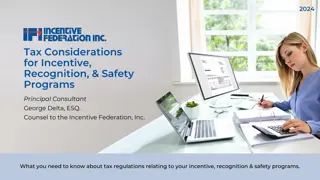
![Town of [Town Name] Real Estate Tax Rates and FY 2024 Budget Summary](/thumb/62211/town-of-town-name-real-estate-tax-rates-and-fy-2024-budget-summary.jpg)
